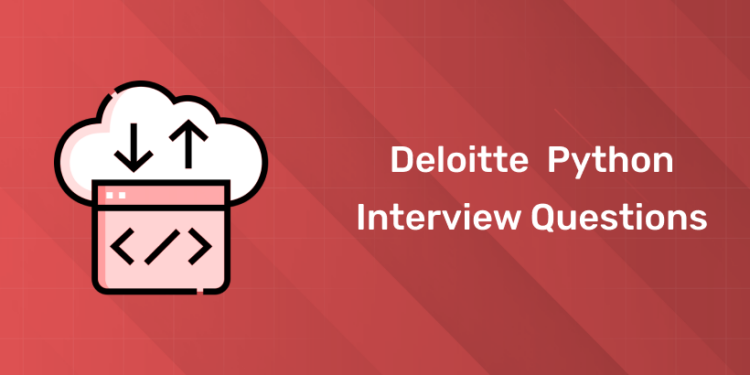Table of Contents
This guide offers questions, answers, and tips for your Deloitte Python interview. It includes preparation advice and common Deloitte Python Interview Questions. Follow the tips given to increase your chances of success. You’ll be well-prepared for your technical interview with Deloitte after reading this. Let us start with the introduction to Deloitte.
Check out this video by Entri in Malayalam!
Get hands-on with our Python course – sign up for a free demo!
Deloitte Python Interview Questions: Introduction
Deloitte is a leading global professional services firm. It works across many industries, offering auditing, consulting, and tax services. Deloitte also provides financial advisory services to its clients. With over 330,000 employees, it’s known for innovation. The firm delivers cutting-edge solutions worldwide.
Preparing for a Python interview at Deloitte is crucial. You’re likely targeting a technical role in their service lines. Python proficiency is now a must-have skill. Deloitte values both technical expertise and cultural fit. Understanding their work environment is key to success.
Why Join Deloitte?
1: Which of the following data types is immutable in Python?
Deloitte is known for being an excellent place to work, especially if you’re starting or growing your career in technology. Here are some reasons why joining Deloitte is a great idea:
1. Career Growth
- Deloitte offers clear paths for career advancement.
- Employees gain experience across diverse, impactful projects.
- Work with major global clients from various industries.
2. Work Environment
- The culture is inclusive and supports collaboration.
- You’ll work with experts in diverse fields.
- Teamwork and knowledge sharing are highly encouraged.
3. Learning Opportunities
- Deloitte provides strong training in soft and technical skills.
- Employees gain hands-on experience with the latest technologies.
- Global teams offer continuous learning opportunities.
4. Employee Benefits
- Competitive salaries and performance-based bonuses.
- Flexible work options promote a healthy work-life balance.
- Comprehensive wellness programs support employee well-being.
5. Global Reach
- Deloitte operates in over 150 countries worldwide.
- Employees work on diverse, global projects.
- The firm values diversity and fresh perspectives.
🚀 Start Coding Today! Enroll Now with Easy EMI Options. 💳✨
Gain expertise in Django and open doors to lucrative opportunities in web development.
Start Learning With EMI Payment OptionsDeloitte Interview Preparation Tips
Preparing for an interview at Deloitte can be challenging, but with the right approach, you can increase your chances of success. Here are some helpful tips to get you ready for the interview:
- Understand the Job Description
Read the job description carefully for Deloitte. Focus on skills, especially Python. Note key requirements and align them with your experience. This will show how you fit the role. - Brush Up on Python Fundamentals
Review basic Python concepts like data structures and syntax. Understand how Python handles variables, loops, and conditions. Be ready to explain Python code and behavior. Refresh your fundamental Python knowledge. - Focus on Python’s Key Libraries
Deloitte uses NumPy, Pandas, and TensorFlow for analysis. Familiarize yourself with these libraries and their applications. Learn how to manipulate data and build models. This knowledge is crucial for the interview. - Practice Problem-Solving and Algorithms
Use platforms like LeetCode, HackerRank, and Codeforces. Focus on sorting, searching, recursion, and dynamic programming. Write efficient code for time and space complexity. Practice regularly to improve problem-solving skills. - Mock Interviews
Do mock interviews with friends or online platforms. Explain your thought process clearly when solving problems. Time yourself to simulate real interview conditions. This practice helps with time management and clarity. - Prepare for Behavioral Questions
Deloitte values teamwork, leadership, and problem-solving skills. Practice answers to questions about overcoming challenges or team projects. Use the STAR method to structure responses effectively. This helps in articulating your experiences clearly. - Research Deloitte’s Culture
Understand Deloitte’s values like integrity, innovation, and inclusion. Be ready to discuss how Deloitte’s mission aligns with your goals. Learn about recent projects and innovations at Deloitte. This shows your interest in the company.
Top Deloitte Python Interview Questions and Answers
Basic Python Questions
1. What is Python?
Python is a high-level, interpreted programming language known for its simplicity. It supports multiple programming paradigms and is widely used in fields like web development, data science, artificial intelligence, and more.
2. What are the key features of Python?
- Simple and Readable: Python’s syntax is easy to learn and use.
- Interpreted: Python is executed line by line, making it easy to debug.
- Dynamic Typing: No need to declare variable types.
- Extensive Libraries: Python has libraries for AI, data science, and more.
- Cross-Platform: Python code runs on multiple operating systems.
3. What are Python’s built-in data types?
Python has several built-in data types like integers, floating-point numbers, strings, lists, tuples, dictionaries, and sets. Each of these is designed for different purposes, like storing numbers, collections of data, or key-value pairs.
4. What is the difference between a list and a tuple in Python?
- List:
- Mutable (can be modified).
- Defined using square brackets: [1, 2, 3].
- Suitable for dynamic data storage.
- Tuple:
- Immutable (cannot be modified).
- Defined using parentheses: (1, 2, 3).
- Suitable for fixed data storage.
5. What is the difference between Python 2 and Python 3?
Python 2 is an older version that is no longer supported, while Python 3 is the modern version. Python 3 introduced many improvements, including better Unicode handling and changes in syntax like the print() function. New projects should always use Python 3.
6. How is memory managed in Python?
- Private Heap: All Python objects are stored in a private heap.
- Reference Counting: Python uses reference counts to track objects.
- Garbage Collection: Cyclic garbage collector to clean up unused objects.
- Dynamic Memory Allocation: Handled by Python’s memory manager.
7. What is PEP 8?
PEP 8 is the style guide for writing Python code. It provides guidelines on how to write clean, readable code, covering naming conventions, indentation, and other coding best practices.
8. What are functions in Python?
- Definition: A block of reusable code that performs a specific task.
- Syntax: Defined using the def keyword.
- Arguments: Functions can take input parameters (arguments).
- Return: They may return a value using the return statement.
Example: Python code
def add(a, b):
return a + b
9. What is the difference between local and global variables?
Local variables are declared within a function and can only be accessed inside that function. Global variables are declared outside all functions and can be accessed anywhere in the program. Global variables can be accessed inside functions, but local variables cannot be accessed outside the function they are declared in.
10. What are Python literals?
- String Literal: ‘Hello’ or “World”.
- Numeric Literal: 10, 3.14.
- Boolean Literal: True, False.
- Special Literal: None, used to represent no value.
Intermediate Python Questions
11. Explain list comprehensions with an example.
List comprehensions provide a concise way to create lists. Instead of using loops, you can generate a list in a single line by applying an expression to each item of an existing list.
Example:
squares = [x**2 for x in range(5)] # Output: [0, 1, 4, 9, 16]
12. What are Python decorators?
- Definition: A function that modifies another function.
- Use Case: Used to add functionality to existing functions.
- Syntax: Uses the @decorator_function syntax.
Example:
@decorator
def my_function():
pass
13. What is the difference between shallow copy and deep copy?
- Shallow Copy: Creates a new object but copies references to nested objects. Changes in nested objects will affect both the original and the copy.
- Deep Copy: Recursively copies all objects, creating an entirely new object. Changes in nested objects in the original do not affect the copy.
14. What are the differences between append() and extend() in lists?
- append(): Adds a single element to the end of the list.
my_list = [1, 2] my_list.append(3) # Output: [1, 2, 3]
- extend(): Adds multiple elements from another iterable to the list.
15. Explain how Python handles exceptions.
Python uses the try-except block to handle exceptions. Code that might raise an error is placed in the try block, and the except block catches and handles the error.
Example:
try:
result = 10 / 0
except ZeroDivisionError:
print(“Cannot divide by zero!”)
16. What is a lambda function in Python?
- Anonymous Function: A function without a name.
- Syntax: Defined using the lambda keyword.
- Use Case: Used for short, simple functions.
Example:
add = lambda x, y: x + y
print(add(2, 3)) # Output: 5
17. What are the key differences between lists and dictionaries?
- Lists: Ordered collections that store elements by index.
- Dictionaries: Unordered collections that store key-value pairs. Lists allow duplicate elements, while dictionary keys must be unique.
18. What are *args and kwargs in Python?
- args: Allows you to pass a variable number of positional arguments to a function.
def add(*args):
return sum(args)
- kwargs: Allows you to pass a variable number of keyword arguments (key-value pairs) to a function.
def print_values(**kwargs):
for key, value in kwargs.items():
print(f”{key}: {value}”)
19. How can you sort a dictionary by value?
You can sort a dictionary by its values using the sorted( ) function and the items( ) method.
Example:
my_dict = {‘a’: 2, ‘b’: 1, ‘c’: 3}
sorted_dict = dict(sorted(my_dict.items(), key=lambda item: item[1]))
# Output: {‘b’: 1, ‘a’: 2, ‘c’: 3}
20. Explain the difference between is and == in Python.
- is: Checks whether two variables point to the same object in memory.
a = [1, 2]
b = a
print(a is b) # Output: True
- ==: Checks whether two variables have the same value.
c = [1, 2] print(a == c) # Output: True
Advanced Python Questions
21. What are generators in Python?
Generators are functions that return an iterator and allow you to iterate over large datasets efficiently. Instead of returning all items at once, they yield items one at a time, making them memory-efficient.
Example:
def count_up_to(max):
count = 1
while count <= max:
yield count
count += 1
22. Explain how Python handles memory management.
- Reference Counting: Each object has a reference count, which tracks the number of references to it.
- Garbage Collection: Python uses a cyclic garbage collector to clean up unused objects that are involved in circular references.
- Private Heap: All objects are stored in Python’s private heap.
23. What are metaclasses in Python?
A metaclass is the class of a class in Python. It defines how classes behave. Metaclasses allow you to control the creation of classes and modify their behavior. By using a metaclass, you can add extra functionality to classes or modify class properties.
24. What is the Global Interpreter Lock (GIL) in Python?
- Definition: The GIL is a mutex that protects access to Python objects and ensures that only one thread executes Python bytecode at a time.
- Impact: It limits the performance of multi-threaded Python programs, especially on multi-core systems.
- Workaround: Use multi-processing instead of multi-threading for CPU-bound tasks.
25. How do you handle file operations in Python?
Python provides built-in functions to handle file operations such as reading, writing, and appending. The most common functions are open( ), read( ), write( ), and close( ).
Example:
with open(‘file.txt’, ‘r’) as file:
content = file.read()
Get hands-on with our Python course – sign up for a free demo!
26. What is monkey patching in Python?
- Definition: Dynamically modifying or extending a class or module at runtime.
- Use Case: Used in testing or when you need to alter behavior without changing the original code.
Example:
class A:
def display(self):
print(“Original”)
def monkey_patched_display():
print(“Monkey Patched”)
A.display = monkey_patched_display
a = A()
a.display() # Output: Monkey Patched
27. How do you implement inheritance in Python?
Inheritance allows one class (child) to inherit attributes and methods from another class (parent). Python supports single inheritance, multiple inheritance, and multilevel inheritance.
Example:
class Animal:
def speak(self):
return “Animal Sound”
class Dog(Animal):
def speak(self):
return “Bark”
28. What is the difference between a class method and a static method?
- Class Method:
- Uses the @classmethod decorator.
- Takes cls as the first argument, referring to the class.
- Can modify class state that applies to all instances.
- Static Method:
- Uses the @staticmethod decorator.
- Does not take self or cls as an argument.
- Cannot modify class or instance state.
29. How can you implement multithreading in Python?
Multithreading in Python is handled using the threading module. You can create and manage threads to perform multiple tasks concurrently. However, due to the Global Interpreter Lock (GIL), threads in Python do not run in parallel on multi-core systems for CPU-bound tasks.
Example:
import threading
def print_numbers():
for i in range(5):
print(i)
thread = threading.Thread(target=print_numbers)
thread.start()
30. How do you use the map() function in Python?
- Definition: The map( ) function applies a function to all items in an input list.
- Syntax: map(function, iterable).
- Use Case: Useful for applying transformations to lists or other iterables.
Example:
numbers = [1, 2, 3, 4] squared = list(map(lambda x: x**2, numbers)) # Output: [1, 4, 9, 16]
Object-Oriented Programming (OOP) in Python
31. What is Object-Oriented Programming (OOP) in Python?
Object-Oriented Programming (OOP) is a paradigm that organizes code into objects, which contain data (attributes) and functions (methods). Python supports OOP, allowing you to create reusable and modular code.
32. What is the difference between a class and an object?
- Class:
- A blueprint for creating objects.
- Defines properties and behavior.
- Example: class Dog: pass
- Object:
- An instance of a class.
- Example: my_dog = Dog()
33. What is polymorphism in Python?
Polymorphism allows the same function or method to work in different ways depending on the object. For example, different classes can have methods with the same name, but the behavior will be specific to each class.
Example:
class Dog:
def sound(self):
return “Bark”
class Cat:
def sound(self):
return “Meow”
def animal_sound(animal):
print(animal.sound())
dog = Dog()
cat = Cat()
animal_sound(dog) # Output: Bark
animal_sound(cat) # Output: Meow
34. What is inheritance in Python?
- Definition: A class can inherit properties and methods from another class.
- Parent Class: The class being inherited from.
- Child Class: The class that inherits from the parent.
Example:
class Animal:
def eat(self):
print(“Eating”)
class Dog(Animal):
def bark(self):
print(“Barking”)
Error Handling
35. What is exception handling in Python?
Exception handling in Python is done using the try, except, finally, and else blocks. This allows you to manage errors gracefully, preventing the program from crashing when an error occurs.
Example:
try:
result = 10 / 0
except ZeroDivisionError:
print(“Cannot divide by zero!”)
finally:
print(“Execution complete.”)
36. What is the difference between syntax errors and exceptions?
- Syntax Error:
- Occurs when the code has incorrect syntax.
- Detected by the interpreter before execution.
- Example: if a == 3 print(“Hello”) (missing :).
- Exception:
- Occurs during program execution.
- Detected when the program encounters an unexpected condition.
- Example: Division by zero error.
File Handling
37. How do you open and read a file in Python?
You can open and read a file using the open( ) function in Python. Files can be opened in different modes like read (‘r’), write (‘w’), append (‘a’), and more.
Example:
with open(‘file.txt’, ‘r’) as file:
content = file.read()
print(content)
38. What is the difference between read(), readline(), and readlines()?
- read():
- Reads the entire content of the file as a single string.
- readline():
- Reads a single line from the file.
- readlines():
- Reads all lines and returns them as a list of strings.
Data Structures
39. What is a dictionary in Python?
A dictionary is a built-in data structure that stores data in key-value pairs. Dictionaries are mutable and allow for fast retrieval of values using keys.
Example:
my_dict = {‘name’: ‘John’, ‘age’: 30}
print(my_dict[‘name’]) # Output: John
40. How do you merge two dictionaries in Python?
- Using the update( ) method:
dict1 = {‘a’: 1}
dict2 = {‘b’: 2}
dict1.update(dict2) # Output: {‘a’: 1, ‘b’: 2}
- Using the * * operator:
merged_dict = {**dict1, **dict2}
41. What is a set in Python, and how does it differ from a list?
- Set:
-
- An unordered collection of unique elements.
- Defined using curly braces: {1, 2, 3}.
- No duplicate values.
- List:
- An ordered collection of elements.
- Defined using square brackets: [1, 2, 3].
- Allows duplicate values.
Data Manipulation
42. How do you remove duplicates from a list in Python?
You can remove duplicates from a list by converting it to a set, which automatically removes duplicates. You can then convert it back to a list if needed.
Example:
my_list = [1, 2, 2, 3, 3]
unique_list = list(set(my_list))
print(unique_list) # Output: [1, 2, 3]
43. What are the different ways to concatenate strings in Python?
- Using the ‘+’ operator:
s1 = “Hello”
s2 = “World”
result = s1 + ” ” + s2 # Output: “Hello World”
- Using the join( ) method:
result = ” “.join([s1, s2]) # Output: “Hello World”
Regular Expressions
44. What are regular expressions in Python?
Regular expressions (regex) are sequences of characters that define search patterns. In Python, you can use the ‘re’ module to work with regular expressions for pattern matching and text manipulation.
Example:
import re
pattern = r’\d+’ # Matches one or more digits
result = re.findall(pattern, ‘There are 3 cats and 4 dogs.’)
print(result) # Output: [‘3’, ‘4’]
45. What is the difference between re.search() and re.findall( )?
- re.search():
- Returns the first match found in the string.
- re.findall():
- Returns all matches found in the string as a list.
Iterators and Generators
46. What are iterators in Python?
An iterator is an object that allows you to iterate over a collection of elements one at a time. In Python, an object is an iterator if it implements the __iter__( ) and __next__( ) methods.
Example:
print(next(iterator)) # Output: 1
47. How is a generator different from an iterator?
- Generator:
- A type of iterator that yields items lazily (one at a time).
- Defined using the yield keyword.
- Iterator:
- A general object used for iterating over collections.
- Requires implementing __iter__( ) and __next__( ) methods.
Concurrency and Parallelism
48. How can you achieve parallelism in Python?
Parallelism in Python can be achieved using the multiprocessing module, which allows you to run multiple processes in parallel, taking advantage of multiple CPU cores.
Example:
from multiprocessing import Pool
def square(n):
return n * n
with Pool(5) as p:
result = p.map(square, [1, 2, 3, 4, 5])
print(result) # Output: [1, 4, 9, 16, 25]
49. What is the difference between threading and multiprocessing?
- Threading:
- Allows multiple threads within a single process.
- Limited by the Global Interpreter Lock (GIL).
- Suitable for I/O-bound tasks.
- Multiprocessing:
- Runs separate processes, each with its own Python interpreter.
- Can achieve true parallelism.
- Suitable for CPU-bound tasks.
Data Science Libraries
50. What is Pandas, and how is it used in Python?
Pandas is a powerful Python library used for data manipulation and analysis. It provides data structures like DataFrame and Series, which are designed for handling structured data efficiently.
Example:
import pandas as pd
data = {‘name’: [‘John’, ‘Anna’], ‘age’: [30, 25]}
df = pd.DataFrame(data)
print(df)
Get hands-on with our Python course – sign up for a free demo!
Deloitte Python Interview Questions: Conclusion
Preparation is key for a Deloitte Python interview. Focus on technical skills, understanding Deloitte’s work culture, and practicing the right questions. Boost your preparation with our Python Programming Course, designed to master Python with real-world projects and expert guidance.
|
Related Articles |
|
🚀 Start Coding Today! Enroll Now with Easy EMI Options. 💳✨
Gain expertise in Django and open doors to lucrative opportunities in web development.
Start Learning With EMI Payment OptionsFrequently Asked Questions
What types of Python questions can I expect in a Deloitte interview?
Expect questions on Python basics and advanced concepts. They cover data types, loops, and functions. Be ready for list comprehension and decorators. You may solve coding problems or debug scripts.
How does Deloitte evaluate Python skills during interviews?
Deloitte assesses core concept understanding and real-world application. They value clear explanations and efficient problem-solving. Familiarity with Python libraries is important. Coding challenges and technical discussions are common.
Are there specific Python libraries I should focus on for a Deloitte interview?
Focus on Pandas, NumPy, and matplotlib for data analysis. Flask or Django are useful for web development roles. Familiarity with these libraries can be beneficial. Review their practical applications.
How important are Python projects on my resume for a Deloitte interview?
Python projects are crucial for demonstrating practical experience. They show real-world application and problem-solving skills. Deloitte will discuss your projects in detail. Focus on challenges faced and results achieved.
Does Deloitte ask behavioral questions alongside Python technical questions?
Yes, Deloitte includes behavioral questions in their interviews. They assess problem-solving, teamwork, and leadership. Be prepared to discuss experiences using the STAR method. Align your answers with Deloitte’s values.
How should I prepare for a Deloitte Python coding challenge?
Practice coding problems on LeetCode, HackerRank, or CodeSignal. Write clean, efficient code and explain your logic. Review common Python interview questions. Focus on problem-solving and code efficiency.
How much emphasis does Deloitte place on Python in technical interviews?
Deloitte places significant emphasis on Python skills. It’s crucial for roles involving data analysis or software development. Python’s versatility is highly valued. Strong Python skills can differentiate you from other candidates.













